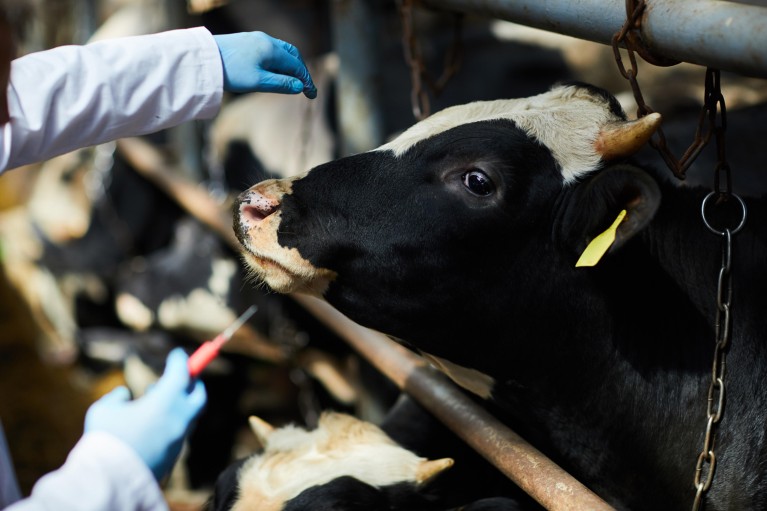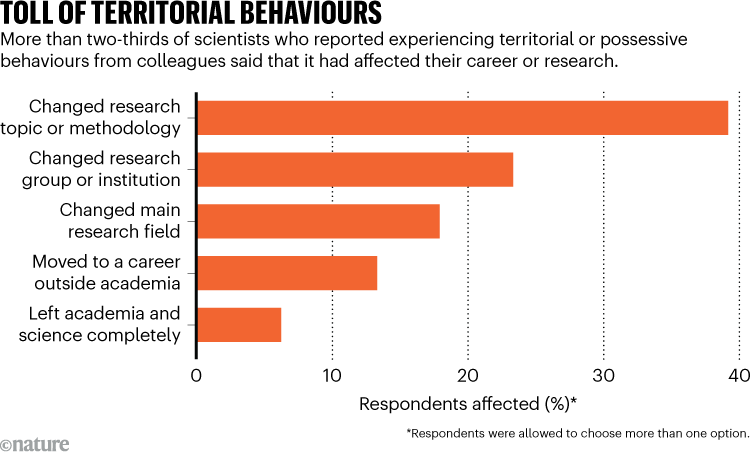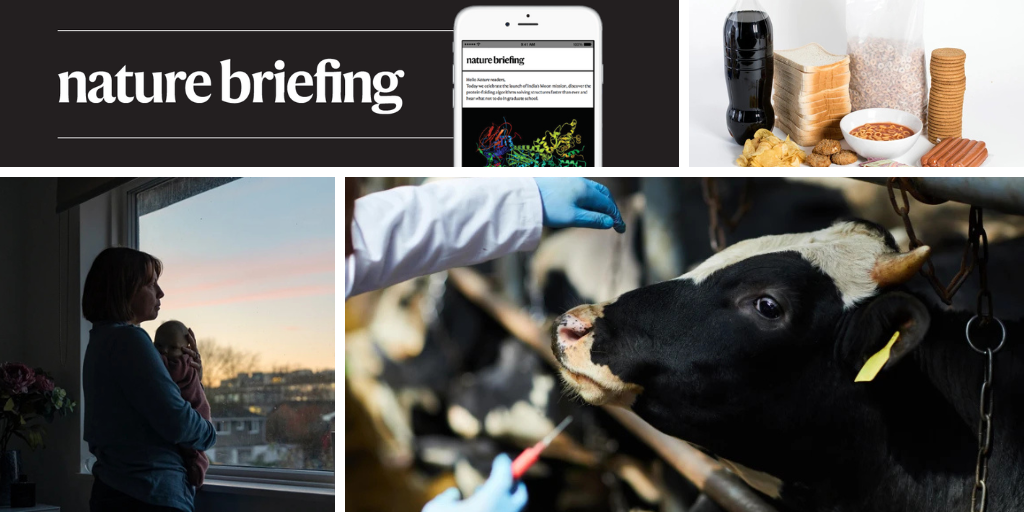You have full access to this article via your institution.
Hello Nature readers, would you like to get this Briefing in your inbox free every day? Sign up here.

Bird-flu vaccines for cattle could reduce the risk of animal-to-human transmission of the H5N1 virus.Credit: Dmitriy Shironosov/Alamy
Researchers have developed the first mRNA bird-flu vaccine for cattle. Early results suggest that the vaccine triggers a strong immune response to the virus, and curbs infection in calves given milk from H5N1-infected cows — a suspected route of transmission among cattle. A widely-used vaccine for livestock could reduce the risk of animal-to-human transmission of a virus that poses a “real pandemic threat”, says virologist and study co-author Scott Hensley. He and his team are working on further trials in adult lactating cows.
Reference: bioRxiv preprint (not peer reviewed)
Molecules in blood and urine can reveal how much of a person’s diet comes from ultra-processed foods — industrially manufactured items that often contain ingredients such as additives and emulsifiers. These measurements provide a way to track consumption of such foods that doesn’t rely on self-reporting — and would be useful for investigating links to diseases such as diabetes and cancer.
Reference: PLOS Medicine paper
Researchers have created a machine-learning tool that can predict, to some extent, who might be at high risk for developing postpartum depression. The tool was trained and validated with data from more than 29,000 people who gave birth in the United States. Of the people that the model flagged as having a high risk of postpartum depression, 30% went on to develop the condition. “Even some degree of prediction can be helpful because we simply don’t have the resources to give everyone the follow-up care that we wish we could as far as postpartum mental health,” says psychiatrist Roy Perlis.
Reference: American Journal of Psychiatry paper
Research organizations in the United States are locked in a court battle with the administration of US president Donald Trump over its plan to cap payments for indirect costs. This funding has typically topped up research grants by up to 70% to cover expenses such as electricity and IT — an amount that was already insufficient in some cases to cover the real cost of doing research, say observers. The US National Science Foundation (NSF) has temporarily paused a move to cap overhead payments on new research grants at 15%. A coalition of 13 US universities and 3 academic associations are seeking to stop the policy, alleging that there are several restrictions on the NSF’s ability to change overhead rates abruptly or unilaterally.
Almost half of the scientists who responded to a survey have experienced the ‘Gollum effect’ — possessive behaviours, attempts to undermine others, and efforts to restrict access to data, resources or opportunities from other scientists. Of those affected, nearly half said that the perpetrator was a high-profile researcher, and one-third said it was their own supervisor. These gatekeeping behaviours “damage careers, particularly of early-career and marginalized researchers”, says study author Jose Valdez. “Most alarming was that nearly one in five of those affected left academia or science entirely.”

Source: Ref. 1.
Features & opinion
When Nature reporter Ewen Callaway tried making a protein using an artificial-intelligence (AI) protein language model, it didn’t change the world: the molecule probably couldn’t be made in the laboratory, let alone do anything useful. But a new generation of AI tools offers new hope to dabblers in computational biology. These tools take instructions in plain language and turn them into proteins and other molecules, including potential drugs. The models also allow researchers to ‘talk’ to cells in ordinary English to decipher their inner workings and glean other biological insights.
In her new book Monopolizing Knowledge, historian of science and technology Jessica Ratcliff documents how manuscripts and specimens gathered by the East India Company formed the foundation of modern science in the United Kingdom. These included “many accumulated through organized looting and plunder”, notes sociologist Zaheer Baber in his review. These items were eventually donated or sold to museums — a colonial legacy that leaves these institutions with a “huge dilemma”, writes Ratcliff.
As a new professor, marketing scholar Lan Nguyen Chaplin felt bruised by the scattershot negativity in anonymous student evaluations. With experience, she came to realize that “the same qualities that made me some students’ ‘best professor’ were exactly what others found ‘annoying’ or made my class ‘a waste of time’”, she writes. “The evaluations were as much about students’ diverse preferences and expectations as about me.” Now she focuses on the feedback about her work as an educator, and treats comments about her voice, clothing and facial expressions as “noise”.
Every day is tea day in my house, but I’m still delighted to be celebrating International Tea Day. The time seems right to remind you of chemist Michelle Francl’s secret to a great cup of tea: a pinch of salt. Last year, she divulged that sodium ions block the taste receptors in our mouths so the drink tastes less bitter. Her other top tips: pre-warm the pot, use loose tea and give it a constant stir — all will help extract more caffeine and antioxidants. Whatever you do (and I can’t imagine that you would) — never make tea in the microwave. “You end up getting tea scum forming on the surface, and that scum contains some of the antioxidants and taste compounds,” says Francl.
While I sit frozen with indecision, salt shaker poised above my cuppa, why not send me your feedback on this newsletter? Your e-mails are always welcome at [email protected].
Thanks for reading,
Flora Graham, senior editor, Nature Briefing
With contributions by Jacob Smith
Want more? Sign up to our other free Nature Briefing newsletters:
• Nature Briefing: Careers — insights, advice and award-winning journalism to help you optimize your working life
• Nature Briefing: Microbiology — the most abundant living entities on our planet — microorganisms — and the role they play in health, the environment and food systems
• Nature Briefing: Anthropocene — climate change, biodiversity, sustainability and geoengineering
• Nature Briefing: AI & Robotics — 100% written by humans, of course
• Nature Briefing: Cancer — a weekly newsletter written with cancer researchers in mind
• Nature Briefing: Translational Research — covers biotechnology, drug discovery and pharma


